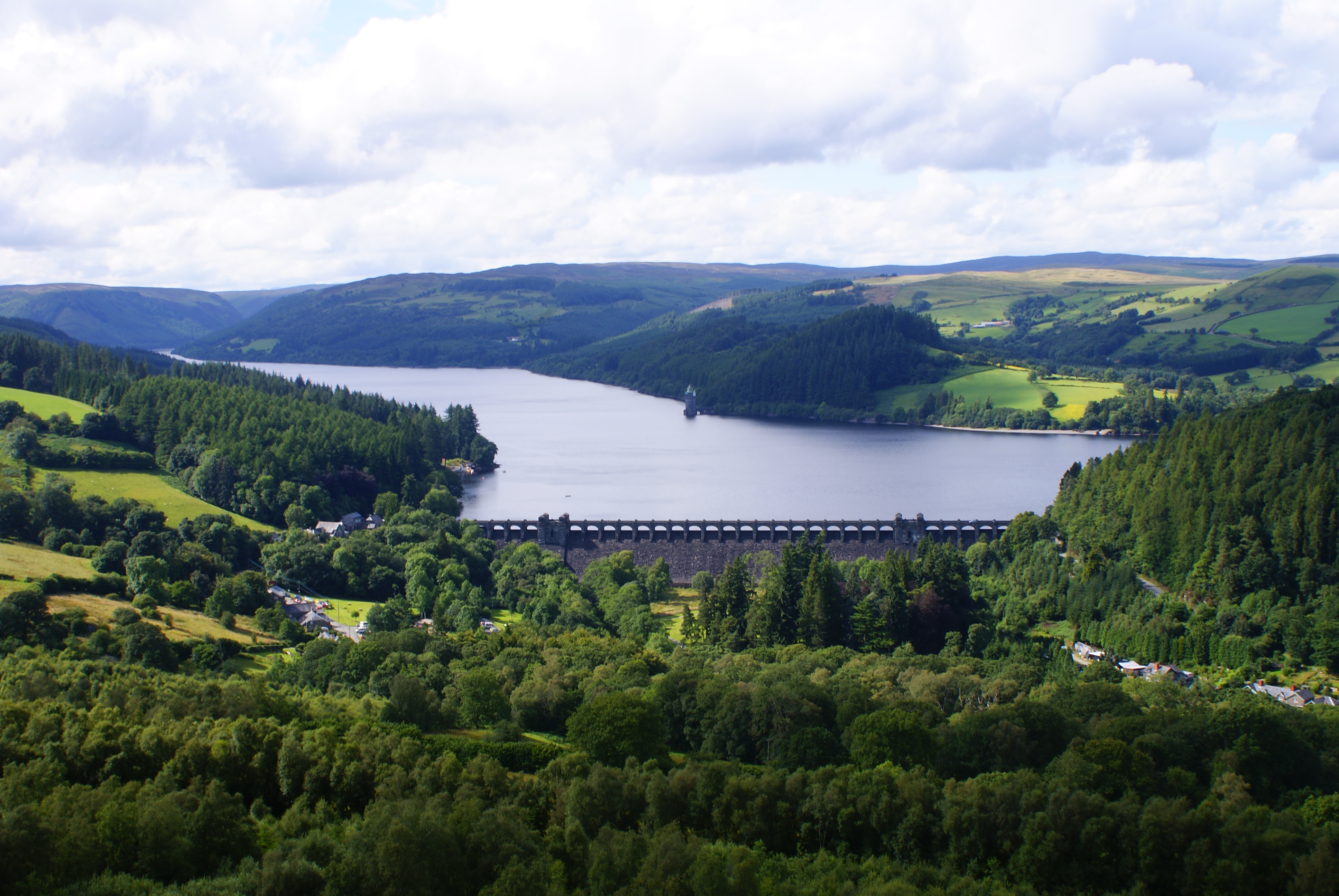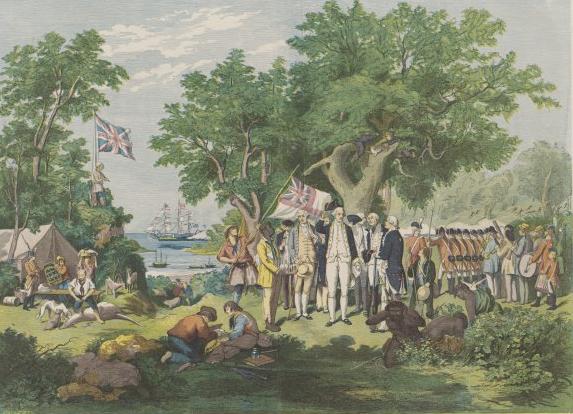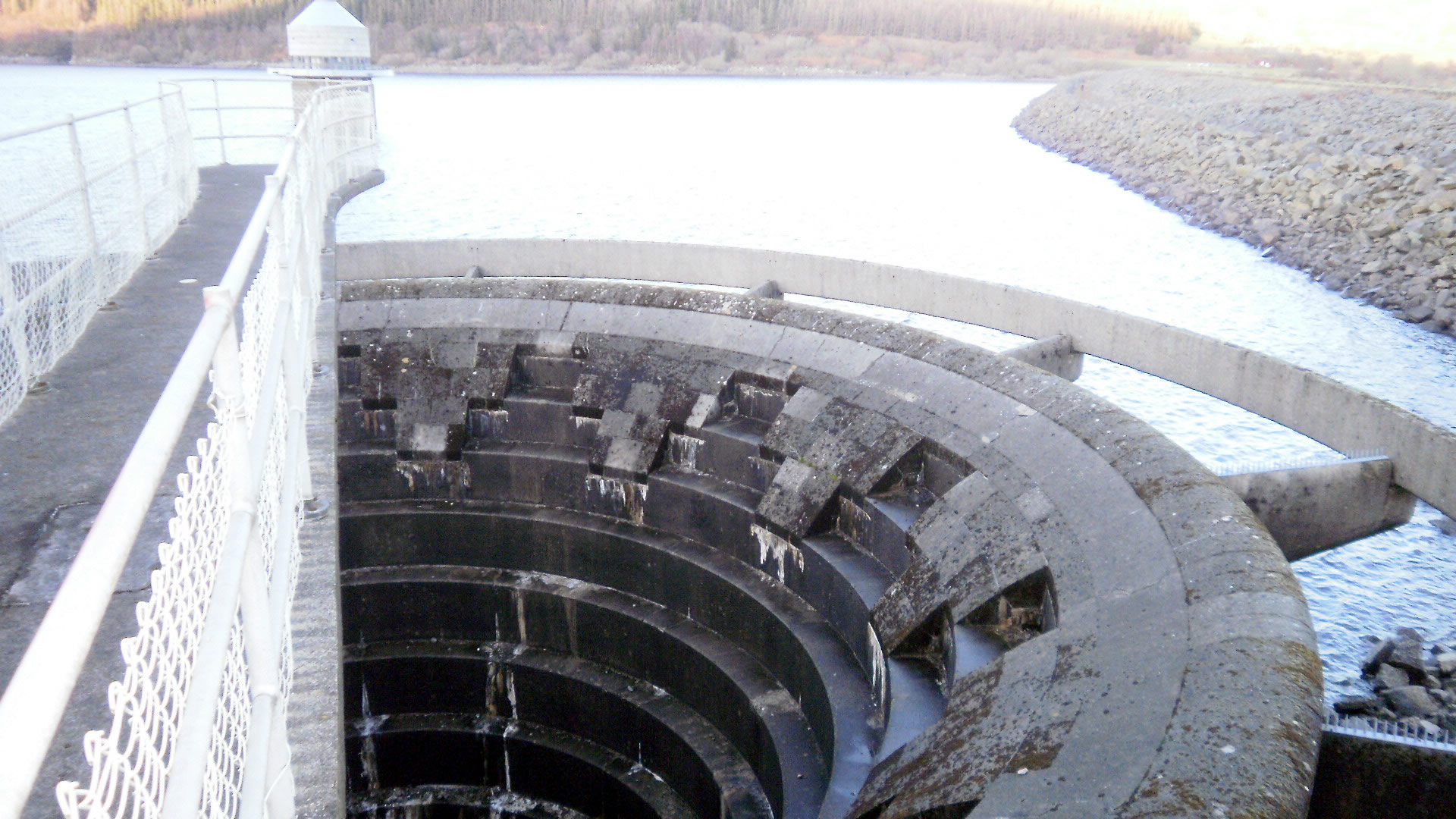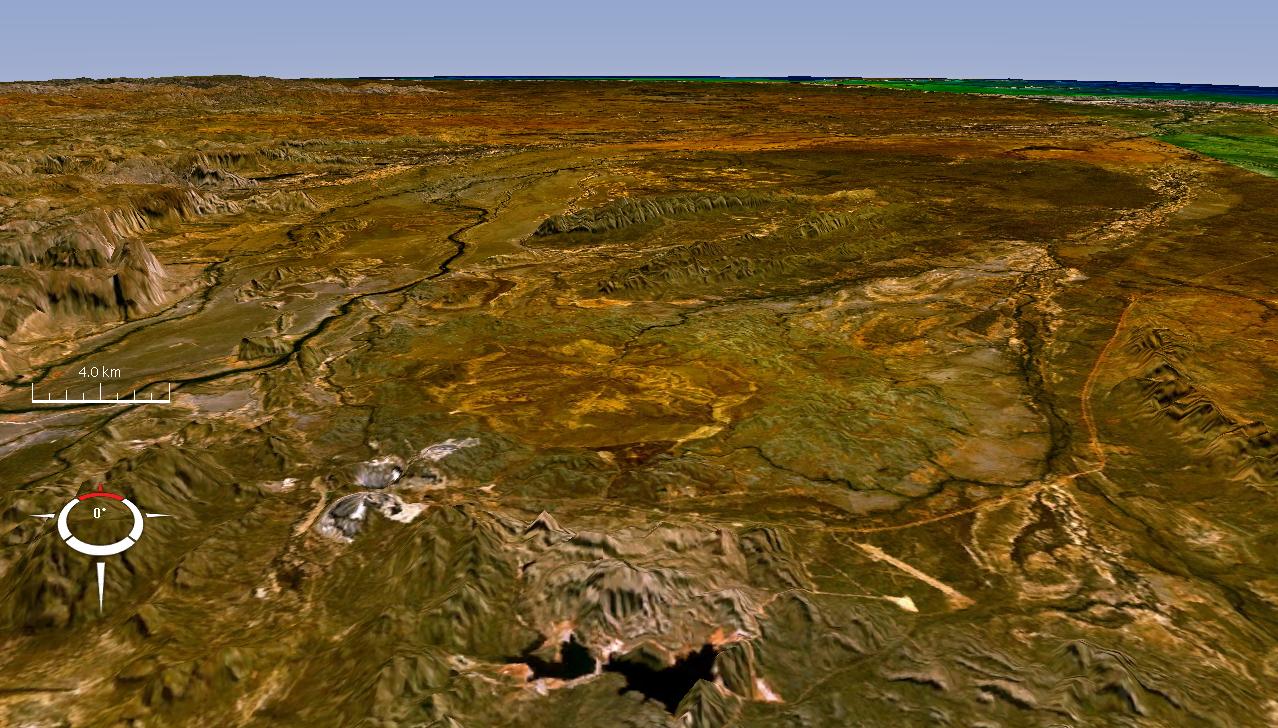|
Lake Julius
Lake Julius was formed following the construction of Julius Dam in 1976 for irrigation and town water storage. The dam wall is located just below the junction of the Leichhardt River and Paroo Creek some North East of Mount Isa. With a catchment area of 4,845 square kilometres it has a full supply capacity of , a surface area of with an average depth of . The dam is unique in Queensland and is a concrete multiple arch and buttress type structure, with the spillway discharging over the tops of the arches. The spillway crest is above bed level. The arch barrels, founded on a triangular arch base, are constructed in independent arch rings and are hinged at buttress springing lines. The spillway is a precast superstructure and the dissipation slab at ground level is post tensioned to the foundation rock. The dam has a total storage capacity of , and has a full supply level of 223.54m AHD. After recording its lowest level of 0% in September 2002, the dam filled to a maximum of 16 ... [...More Info...] [...Related Items...] OR: [Wikipedia] [Google] [Baidu] |
Mount Isa
Mount Isa ( ) is a city in the Gulf Country region of Queensland, Australia. It came into existence because of the vast mineral deposits found in the area. Mount Isa Mines (MIM) is one of the most productive single mines in world history, based on combined production of lead, silver, copper and zinc. With an urban population of 18,727 in 2021 census, Mount Isa is the administrative, commercial and industrial centre for the state's vast north-western region. Although situated in an arid area, the artificial Lake Moondarra north of the city on the Leichhardt River provides both drinking water and an area for watersports, birdwatching and recreation. Locals often refer to Mount Isa as "The Isa". Due to the lead production in the city, Mount Isa has one of the most intensive air quality monitoring systems in Australia. Concerns have been raised over childhood lead contamination and air pollution within the city. The Mount Isa Mines (MIM) in particular are a source of signi ... [...More Info...] [...Related Items...] OR: [Wikipedia] [Google] [Baidu] |
Reservoir
A reservoir (; from French ''réservoir'' ) is an enlarged lake behind a dam. Such a dam may be either artificial, built to store fresh water or it may be a natural formation. Reservoirs can be created in a number of ways, including controlling a watercourse that drains an existing body of water, interrupting a watercourse to form an embayment within it, through excavation, or building any number of retaining walls or levees. In other contexts, "reservoirs" may refer to storage spaces for various fluids; they may hold liquids or gasses, including hydrocarbons. ''Tank reservoirs'' store these in ground-level, elevated, or buried tanks. Tank reservoirs for water are also called cisterns. Most underground reservoirs are used to store liquids, principally either water or petroleum. Types Dammed valleys Dammed reservoirs are artificial lakes created and controlled by a dam constructed across a valley, and rely on the natural topography to provide most of the basin ... [...More Info...] [...Related Items...] OR: [Wikipedia] [Google] [Baidu] |
Leichhardt River
The Leichhardt River is a river in north west Queensland, Australia. Course The source of the river is in the Selwyn Range under Rifle Creek Hill and fed by Rifle Creek approximately south of the mining town Mount Isa. It runs in a generally northerly direction almost parallel with the Diamantina Developmental Road until it reaches Mount Isa and crosses the Barkly Highway. It continues in a north easterly direction across the Gulf Country passing through Lake Moondarra past Glenroy Station then through Lake Julius. It then bears east then north again almost parallel with the Burke Developmental Road until crossing it near Nardoo. Continuing north past Augustus Downs Station to its mouth at the Gulf of Carpentaria. The river is named after the early explorer of Australia, Ludwig Leichhardt. Catchment Leichhardt River has a catchment area of . Primary activities undertaken in the watershed include mining and grazing. The river is ephemeral and in the dry season the upstream ... [...More Info...] [...Related Items...] OR: [Wikipedia] [Google] [Baidu] |
Queensland
) , nickname = Sunshine State , image_map = Queensland in Australia.svg , map_caption = Location of Queensland in Australia , subdivision_type = Country , subdivision_name = Australia , established_title = Before federation , established_date = Colony of Queensland , established_title2 = Separation from New South Wales , established_date2 = 6 June 1859 , established_title3 = Federation of Australia, Federation , established_date3 = 1 January 1901 , named_for = Queen Victoria , demonym = , capital = Brisbane , largest_city = capital , coordinates = , admin_center_type = Administration , admin_center = Local government areas of Queensland, 77 local government areas , leader_title1 = Monarchy of Australia, Monarch , leader_name1 = Charles III , leader_title2 = Governor of Queensland, Governor , leader_name2 = Jeannette Young , leader_title3 = Premier of Queensland, Premier , leader_name3 = Annastacia Palaszczuk (Australian Labor Party (Queensland Branch), AL ... [...More Info...] [...Related Items...] OR: [Wikipedia] [Google] [Baidu] |
Arch
An arch is a vertical curved structure that spans an elevated space and may or may not support the weight above it, or in case of a horizontal arch like an arch dam, the hydrostatic pressure against it. Arches may be synonymous with vaults, but a vault may be distinguished as a continuous arch forming a roof. Arches appeared as early as the 2nd millennium BC in Mesopotamian brick architecture, and their systematic use started with the ancient Romans, who were the first to apply the technique to a wide range of structures. Basic concepts An arch is a pure compression form. It can span a large area by resolving forces into compressive stresses, and thereby eliminating tensile stresses. This is sometimes denominated "arch action". As the forces in the arch are transferred to its base, the arch pushes outward at its base, denominated "thrust". As the rise, i. e. height, of the arch decreases the outward thrust increases. In order to preserve arch action and prevent coll ... [...More Info...] [...Related Items...] OR: [Wikipedia] [Google] [Baidu] |
Spillway
A spillway is a structure used to provide the controlled release of water downstream from a dam or levee, typically into the riverbed of the dammed river itself. In the United Kingdom, they may be known as overflow channels. Spillways ensure that water does not damage parts of the structure not designed to convey water. Spillways can include floodgates and fuse plugs to regulate water flow and reservoir level. Such features enable a spillway to regulate downstream flow—by releasing water in a controlled manner before the reservoir is full, operators can prevent an unacceptably large release later. Other uses of the term "spillway" include bypasses of dams and outlets of channels used during high water, and outlet channels carved through natural dams such as moraines. Water normally flows over a spillway only during flood periods, when the reservoir has reached its capacity and water continues entering faster than it can be released. In contrast, an intake tower is a stru ... [...More Info...] [...Related Items...] OR: [Wikipedia] [Google] [Baidu] |
SunWater
Sunwater, the trading name of Sunwater Limited, is a statutory Queensland Government -owned corporation that supplies bulk water to over customers and water consultancy services to a range of institutional clients in the Wide Bay–Burnett and North West regions of Queensland, Australia. Sunwater was established on 1 October 2000 pursuant to the and the Function and activities Sunwater is responsible for the operation and maintenance of 19 major dams, 63 weirs, 80 major pumping stations and more than of pipelines and open channels. Water storage infrastructure managed by Sunwater includes: * Burdekin Falls Dam * Bjelke-Petersen Dam * Kinchant Dam * Wuruma Dam SunWater constructed, and owns and operates the Tinaroo Hydro Power Station, a mini hydroelectric power station A power station, also referred to as a power plant and sometimes generating station or generating plant, is an industrial facility for the generation of electric power. Power stations are g ... [...More Info...] [...Related Items...] OR: [Wikipedia] [Google] [Baidu] |
List Of Dams And Reservoirs In Australia
Dams and reservoirs in Australia is a link page for any dam or reservoir in Australia. Australian Capital Territory There are three key water storage facilities located in the Australian Capital Territory. The fourth source of water for Canberra, Googong Dam, is in NSW. In addition, there are four smaller man-made reservoirs used for recreation and as traps for sediment and fertilizers . New South Wales There are dams, weirs, catchments, and barrages in New South Wales. Of these, 135 facilities are considered major dams according to the Australian National Committee on Large Dams. Dams and reservoirs The largest reservoir in New South Wales is the Lake Eucumbene in the Snowy Mountains, formed by the Eucumbene Dam. Weirs and barrages Cancelled and decommissioned Northern Territory There are 805 named water storage facilities located in the Northern Territory. Of these, four facilities are considered major dams according to the Australian National Committee on ... [...More Info...] [...Related Items...] OR: [Wikipedia] [Google] [Baidu] |
North West Queensland
The Gulf Country is the region of woodland and savanna grassland surrounding the Gulf of Carpentaria in north western Queensland and eastern Northern Territory on the north coast of Australia. The region is also called the Gulf Savannah. It contains large reserves of zinc, lead and silver. The Gulf Country is crossed by the Savannah Way highway. Location and description The Gulf Country is a block of dry savanna between the wetter areas of Arnhem Land and the Top End of the Northern territory to the west and the Cape York Peninsula of Far North Queensland to the east, while to the south and east lie upland plains of Mitchell grasses and the Einasleigh Uplands. The Northern Territory side of the area is the Gulf Fall area of sandstone slopes and gorges draining the interior uplands into the gulf. The main land uses in the Gulf Country are beef cattle and mining. The region covers an area of . The landscape is generally flat and low-lying tropical savannah cut through with ... [...More Info...] [...Related Items...] OR: [Wikipedia] [Google] [Baidu] |





